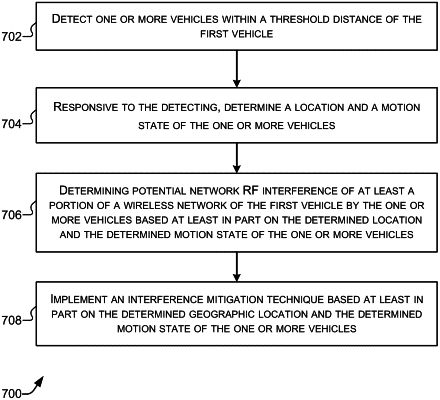| CPC H04W 4/46 (2018.02) [B60W 30/08 (2013.01); H04W 52/44 (2013.01); B60W 2554/4041 (2020.02); B60W 2556/65 (2020.02); B60W 2710/30 (2013.01)] | 25 Claims |

|
1. A method of detecting and mitigating radio frequency (RF) interference at a first vehicle, the method comprising:
detecting one or more vehicles within a predetermined threshold distance of the first vehicle, wherein the detecting the one or more vehicles comprises:
receiving one or more return signals from a sensor of the first vehicle, wherein the sensor comprises a radar, a LiDAR, a camera, an ultrasound sensor, or any combination thereof;
determining a distance of the one or more vehicles based on the one or more return signals; and
comparing the distance of the one or more vehicles to the predetermined threshold distance;
responsive to the detecting, determining a location and a motion state of the one or more vehicles;
determining potential RF interference of at least a portion of a wireless network of the first vehicle by the one or more vehicles based at least in part on the determined location and the determined motion state of the one or more vehicles; and
implementing an interference mitigation technique based at least in part on the determined location, the determined motion state of the one or more vehicles, and detecting a second vehicle being within one of a first threshold distance or a second threshold distance from the first vehicle, wherein the first threshold distance is determined based on a first rate of approach of a second vehicle towards the first vehicle, and the second threshold distance is determined based on a second rate of approach of the second vehicle towards the first vehicle.
|